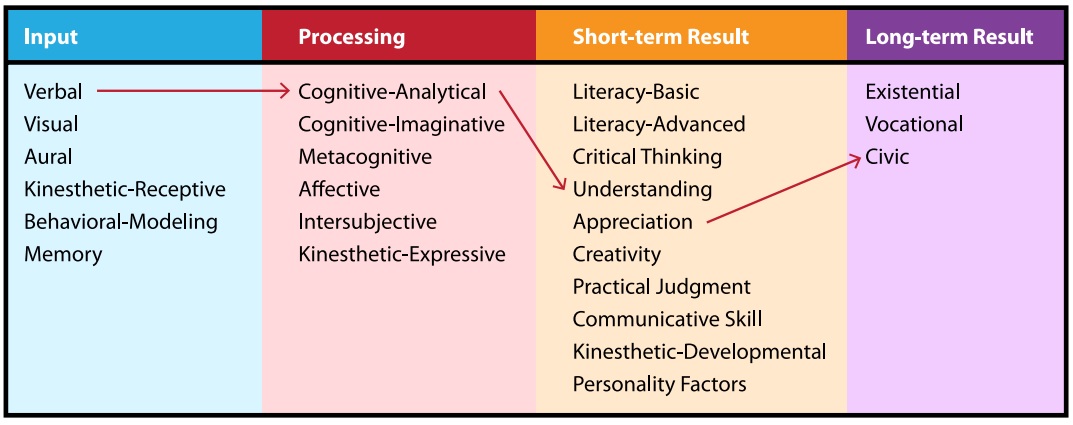Can we better understand the impact of the arts via studies in related disciplines? Since 2012, researchers at the Harvard Graduate School of Education’s Humanities and Liberal Arts Assessment (HULA) project have been exploring how the knowledge and practice of humanities help advance human development – using tools developed within the humanist discipline.
In a previous Createquity Research Spotlight, we wrote about the “What Works” initiative in the UK, which borrows a policy evaluation methodology from the medical community and applies it to (among other things) the arts. In this case, HULA is developing metrics to evaluate arts and humanities using the discipline’s own tools.
HULA does this by repositioning the humanities as “an assemblage of craft practices,” whereby each craft embodies distinctive goals, logical methods,and results that are passed from master to apprentice over thousands of years. For example, in the craft of pottery-making, we could attribute a set of tools, techniques, and sequencing – a general sense of purposeful and procedural logic – that all contribute toward creating a beautiful or useful product. By organizing humanities as individual practices and crafts, we can start to identify different steps, logical patterns, and tools that each activity utilizes to produce an outcome.
In this research context, human development itself is the desired outcome. The HULA white paper thus explores three key research questions:
- How do the humanities contribute to human development?
- To what extent are the humanities effective in achieving this goal?
- How can we measure the effects of the humanities anyway?
HULA defines “human development” in terms of education, subdividing that definition in two ways: 1) education as a system of institutions, maintained by the state to serve utilitarian purposes (such as cultivating civic service or civic responsibility); and 2) education as an individual act of instruction, which relates to personal development. In short, the teaching of humanities is likened to the practice of “crafts,” which also help advance education and contribute to human development.
To explore how different humanities practices contribute to these educational outcomes, HULA identifies various elements – or building blocks – that make up different humanities practices. All of these elements are then sorted and coded according to HULA’s proposed methodological framework; this allows us to see which elements are different or common to various humanities practices, and thus track how they lead to similar or dissimilar learning pathways toward the goal of human development.
In Figure 1 below, HULA defines four sequential stages of a learning pathway and attributes possible elements of a given craft to certain learning processes or outcomes: input, processing, and short-term and long-term results. In this example, the red arrows represent the pathway of a political philosophy instructor who engages students in close readings (verbal input) and logical debate (cognitive-analytical analysis), with the aim to encourage understanding of political concepts (the short-term goal), which in turn may enable students to become more civic-minded citizens (the long-term goal).

Figure 1. Example of a HULA Learning Pathway. Adapted from “Humanities and Liberal Arts Assessment White Paper”, by The HULA Research Team. 2015, p.15.
HULA’s application of coding schemes to different humanities activities requires a set of assumptions about each humanities practice or craft, including the elements it comprises, how it works, what it is trying to achieve, and which skills it develops. These assumptions draw on the implicit logic associated with the practice or craft. Once these elements are broken down, the study assigns the process and outcome advanced by each element. The elements are thus coded categorically along a structured framework of possible learning pathways, which allows us to track the progress and outcome of a given humanities practice or craft. To see how this coding process works in detail, the HULA study on 30 Years of Illinois Humanities Council Grant-Making features appendices of the “code structure” and “code sets” used to track the different methods and mechanisms followed by various humanities activities.
Does this sound complicated? Indeed, applying this methodology, with its myriad definitions and categorizations, requires users to absorb concepts that can be rather academic and abstract. This barrier could limit the adoption of HULA’s methodology beyond the realm of the academy.
Still, the research logic of the study is worth a deeper dive. The core concept of its design makes sense, especially when the terms of its application are simplified. Ultimately, by coding and analyzing humanities as a series of crafts – each of which has its own elemental purpose and logic –we have a new way of unpacking what each practice is really about, what elements it comprises, how it works, and towards which learning outcomes it steers.
If we can manage to make the language of the HULA model a bit more accessible, we just might have a promising methodology for assessing the value of the humanities – using evaluation tools drawn from the discipline itself, as opposed to metrics from other disciplines, which are often an imperfect fit.
Cover image: “Pottery” courtesy of Lennart Tange. via Flickr Creative Commons license.